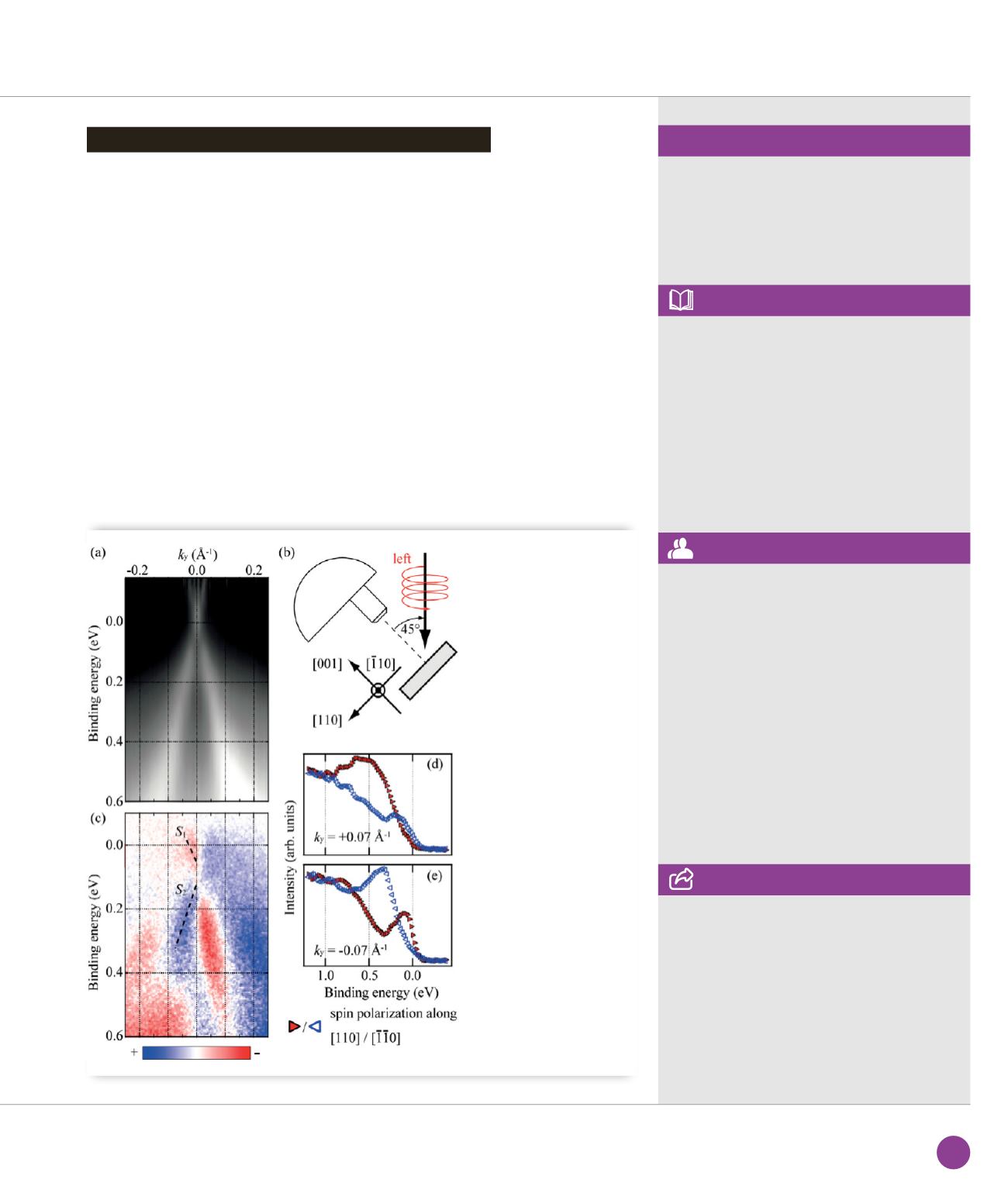
α
-Sn is a zero-gap semiconductor and
a possible candidate for such a new
TI realized by QSE, since its bulk band
structure is already non-trivial: if one can
open a finite size bandgap on
α
-Sn, it
becomes a TI. Although the phase of bulk
Sn is not stable at room temperature (RT),
the epitaxial Sn films grown on lattice-
matched InSb(001) substrates [3] show
the stable
α
phase even above RT.
On the epitaxial
α
-Sn (001) films grown
by molecular beam epitaxy (MBE), we
observed clear dispersion of surface
bands by synchrotron-radiation angle-
resolved photoelectron spectroscopy
(ARPES), as shown in Figure
➋
a
. Rather
high-temperature measurement at 450
K enabled us to observe the surface
electronic structure even above the Fermi
level. Around the Fermi level, the surface
state showed almost massless linear
dispersion. Furthermore, a following study
by circular dichroism of ARPES and spin-
resolved ARPES (Figure
➋
c-e
) showed
helical in-plane spin polarization of the
surface state. Both features indicate that
the surface states observed in this work
are TSS, hence the epitaxial
α
-Sn film
became a TI. We have also performed
a density-functional-theory calculation
and found a good agreement with what
is observed. The theoretical calculation
predicted a finite size bandgap of about
200 meV.
In summary, we could realize a new family
of TI, epitaxial films of alpha-Sn, thanks to
QSE. Its Dirac-cone-shape surface state
dispersion and helical spin polarization
were clearly observed by ARPES using
Synchrotron Radiation.
Spin-polarized Dirac cone on ultrathin Sn(001)
➋
ARPES results on the epitaxial
α
-Sn films.
(a)
ARPES intensity plot of the
24 monolayer film along [-110]
measured with h
α
= 19 eV, divided
by the Fermi-Dirac distribution
at 450 K function convolved
with the instrumental resolution.
(b)
Experimental geometry
in this work.
(c)
ARPES circular-dichroism
plot of the 30 monolayers film
taken with 19 eV photons at RT.
Dichroism is obtained by subtracting
the intensities of left-circularly
polarized photons from those
of right-circularly polarized ones.
(d), (e)
Spin-resolved ARPES spectra
taken at RT with spin polarization
toward [110]/[-1-10]. The acceptance
angle for the spin-resolved ARPES
corresponds to ky = +-0.06 Å
-1
.
CASSIOPEE beamline
ASSOCIATED PUBLICATION
Dirac cone with helical spin polarization
in ultrathin
α
-Sn(001) films
Y. Ohtsubo, P. Le Fèvre, F. Bertran,
and A. Taleb-Ibrahimi*
Physical Review Letters 111(21) (2013),
art.n° 216401
REFERENCES
[1] M.Z. Hasan & C.L.Kane, Rev. Mod. Phys.
2011 83, 1057; X. L. Qi & S. C. Zhang, Rev.
Mod. Phys. 83 (2011), 1057
[2] Y. Zhang et al. Nat. Phys. 6 (2010), 584
[3] R. F. C. Farrow et al. J. Cryst. Growth
54 (1981), 507; M. G. Betti et al. Surf. Sci.
507-510 (2002), 335
* Synchrotron SOLEIL, l’Orme des Merisiers,
St Aubin BP48, 91192 Gif sur Yvette Cedex,
France
CORRESPONDING AUTHOR
25
SOLEIL
HIGHLIGHTS
2013


